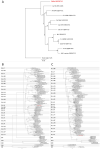Molecular Biology and Pathological Process of an Infectious Bronchitis Virus with Enteric Tropism in Commercial Broilers
- PMID: 34452342
- PMCID: PMC8402673
- DOI: 10.3390/v13081477
Molecular Biology and Pathological Process of an Infectious Bronchitis Virus with Enteric Tropism in Commercial Broilers
Abstract
Infectious bronchitis virus (IBV) induces respiratory and urogenital disease in chickens. Although IBV replicates in the gastrointestinal tract, enteric lesions are uncommon. We have reported a case of runting-stunting syndrome in commercial broilers from which an IBV variant was isolated from the intestines. The isolate, CalEnt, demonstrated an enteric tissue tropism in chicken embryos and SPF chickens experimentally. Here, we determined the full genome of CalEnt and compared it to other IBV strains, in addition to comparing the pathobiology of CalEnt and M41 in commercial broilers. Despite the high whole-genome identity to other IBV strains, CalEnt is rather unique in its nucleotide composition. The S gene phylogenetic analyses showed great similarity between CalEnt and Cal 99. Clinically, vent staining was slightly more frequent in CalEnt-infected birds than those challenged with M41. Furthermore, IBV IHC detection was more evident and the viral shedding in feces was overall higher with the CalEnt challenge compared with M41. Despite underlying intestinal lesions caused by coccidiosis and salmonellosis vaccination, microscopic lesions in CalEnt-infected chickens were more severe than in M41-infected chickens or controls, supporting the enteric tropism of CalEnt. Further studies in SPF chickens are needed to determine the pathogenesis of the virus, its molecular mechanisms for the enteric tropism, and its influence in intestinal health.
Keywords: IBV; enteric tropism; infectious bronchitis; runting-stunting syndrome; variants; whole-genome sequencing.
Conflict of interest statement
The authors declare no conflict of interest.
Figures






References
-
- Wentworth D.E., Holmes K.V. Coronavirus binding and entry. In: Thiel V., editor. Coronaviruses: Molecular and Cellular Biology. Caister Academic Press; Norfulk, UK: 2007.

